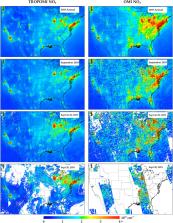- Record: found
- Abstract: found
- Article: found
TROPOMI NO 2 in the United States: A Detailed Look at the Annual Averages, Weekly Cycles, Effects of Temperature, and Correlation With Surface NO 2 Concentrations

Read this article at
Abstract
Observing the spatial heterogeneities of NO 2 air pollution is an important first step in quantifying NO X emissions and exposures. This study investigates the capabilities of the Tropospheric Monitoring Instrument (TROPOMI) in observing the spatial and temporal patterns of NO 2 pollution in the continental United States. The unprecedented sensitivity of the sensor can differentiate the fine‐scale spatial heterogeneities in urban areas, such as emissions related to airport/shipping operations and high traffic, and the relatively small emission sources in rural areas, such as power plants and mining operations. We then examine NO 2 columns by day‐of‐the‐week and find that Saturday and Sunday concentrations are 16% and 24% lower respectively, than during weekdays. We also analyze the correlation of daily maximum 2‐m temperatures and NO 2 column amounts and find that NO 2 is larger on the hottest days (>32°C) as compared to warm days (26°C–32°C), which is in contrast to a general decrease in NO 2 with increasing temperature at moderate temperatures. Finally, we demonstrate that a linear regression fit of 2019 annual TROPOMI NO 2 data to annual surface‐level concentrations yields relatively strong correlation ( R 2 = 0.66). These new developments make TROPOMI NO 2 satellite data advantageous for policymakers and public health officials, who request information at high spatial resolution and short timescales, in order to assess, devise, and evaluate regulations.
Key Points
-
The high instrument sensitivity of Tropospheric Monitoring Instrument (TROPOMI) can measure NO 2 pollution with unprecedented clarity compared to predecessor instruments
-
We can now quantify pollution hotspots within cities such as those related to airport/shipping operations and high traffic areas
-
Annual column NO 2 observed by TROPOMI has good correlation ( R 2 = 0.66) with EPA surface observations without any surface‐to‐column conversion
Related collections
Most cited references109

- Record: found
- Abstract: found
- Article: found
Estimates and 25-year trends of the global burden of disease attributable to ambient air pollution: an analysis of data from the Global Burden of Diseases Study 2015
- Record: found
- Abstract: not found
- Article: not found
TROPOMI on the ESA Sentinel-5 Precursor: A GMES mission for global observations of the atmospheric composition for climate, air quality and ozone layer applications
- Record: found
- Abstract: not found
- Article: not found
The ozone monitoring instrument
Author and article information
Comments
Comment on this article
 Smart Citations
Smart CitationsSee how this article has been cited at scite.ai
scite shows how a scientific paper has been cited by providing the context of the citation, a classification describing whether it supports, mentions, or contrasts the cited claim, and a label indicating in which section the citation was made.